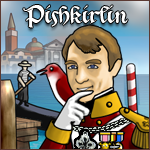The Founding Myth
Knights of Saint George :: The Crown in Right of Ascalon :: Heritage and Royal Institutions :: Heritage
Page 1 of 1
 The Founding Myth
The Founding Myth
At the beginning of the XVIII century, the necromancer Mortesecca, Master of the Arcane, proferred the prophecy:
On July 1707, the infamous Brigand King took over Kasidim Island and set up his headquarter there, but soon after was attacked by the Army Of Darkness. Taking advantage of the mayhem caused by the blockade, Pishkirlin managed to sneak in Masada Palace before it was occupied by the attackers and come into possession of the book. Among its pages could be read:
Pishkirlin set sail to Tern Archipelago and once at the Island, he found Mortesecca waiting for him, and handing him the sacred sword, he offered the Prince the Crown of Ascalon.
Interpretation of the Myth
Behind the seemingly fanciful legend of Ascalon lie historical facts, which the historians of Sage have tried to clarify each according to his or her own interpretation of Mortesecca's prophecy. For the aforesaid prophecy, other than the symbolic importance of the legend itself, two different explanations come to the forefront, neither incompatible with the other.
The "iron" of Saint George's sword could be construed as the iron of the island which bears the same name as the saint's sword: Ashkelon Arch, which is, in fact, rich in that same mineral. The crown of Pishkirlin could therefore have been forged from the iron originating from the island of Ashkelon.
If, however, we interpret "iron" as a metonymy for the sword and thus the blade, then the pirate crew Blades of Ascalon comes immediately to mind; the selfsame crew of which Mortesecca was the first Captain. Thus the necromancer's suggestion to Pishkirlin to unite their crews under one flag when handing him the sword was tantamount to offering Pishkirlin the crown of the kingdom.
Rumors, that the legendary sword with which the Saint slayed the dragon had been brought to Sage by the pirate Waterbug, spread like wildfire. The place where the relic was hidden being unknown, all attempts to find the sword seemed to be in vain. One by one, all of the searchers gave up the hunt as a wild goose chase; all except Prince Pishkirlin of the Fearless Privateers, Grand-Master of the Sacred Military Order of Saint George. Unwilling to abandon his dream of finding the sword, he persisted in his efforts to that purpose. After an accurate research on the Saint's apocryphal hagiographies, he discovered that the book The Illustrious and Renown'd History of the Seven Famous Champions of Christendom contained precious information about the relic and that the last copy of the book supposedly belonged to Vargas the Mad.The Crown of a nation will be forged from the iron of Saint George's sword.
On July 1707, the infamous Brigand King took over Kasidim Island and set up his headquarter there, but soon after was attacked by the Army Of Darkness. Taking advantage of the mayhem caused by the blockade, Pishkirlin managed to sneak in Masada Palace before it was occupied by the attackers and come into possession of the book. Among its pages could be read:
revealing along with the name of the sword, its most likely location: Ashkelon Arch Island.thy sword which is called Ascalon is framed of such excellent mettle by the curious workmanship of the Ciclops, that it will separate and cut the hardest flint, and hew in sunder the strongest steele, for in the pummell lies such pretious vertue, that neyther treason, witchcrafts, nor any violence can bee proffered thee, so long as thou wearest it
Pishkirlin set sail to Tern Archipelago and once at the Island, he found Mortesecca waiting for him, and handing him the sacred sword, he offered the Prince the Crown of Ascalon.
Interpretation of the Myth
Behind the seemingly fanciful legend of Ascalon lie historical facts, which the historians of Sage have tried to clarify each according to his or her own interpretation of Mortesecca's prophecy. For the aforesaid prophecy, other than the symbolic importance of the legend itself, two different explanations come to the forefront, neither incompatible with the other.
The "iron" of Saint George's sword could be construed as the iron of the island which bears the same name as the saint's sword: Ashkelon Arch, which is, in fact, rich in that same mineral. The crown of Pishkirlin could therefore have been forged from the iron originating from the island of Ashkelon.
If, however, we interpret "iron" as a metonymy for the sword and thus the blade, then the pirate crew Blades of Ascalon comes immediately to mind; the selfsame crew of which Mortesecca was the first Captain. Thus the necromancer's suggestion to Pishkirlin to unite their crews under one flag when handing him the sword was tantamount to offering Pishkirlin the crown of the kingdom.

Pishkirlin- Crew: : Knights of Saint George
Knights of Saint George :: The Crown in Right of Ascalon :: Heritage and Royal Institutions :: Heritage
Page 1 of 1
Permissions in this forum:
You cannot reply to topics in this forum

» 8th anniversary
» Crew portrait
» Fame record
» Almost famous.
» Pish is back (for a while)